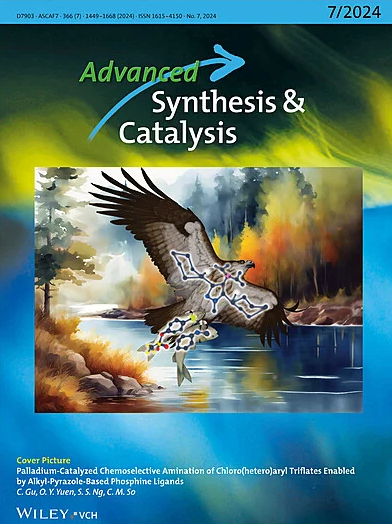二恶唑酮类化合物在过渡金属催化氢酰胺化反应中的应用进展
IF 4
2区 化学
Q2 CHEMISTRY, APPLIED
引用次数: 0
摘要
近年来,过渡金属催化合成酰胺的研究日益成为一个重要的热点。在高效的酰胺化试剂中,二恶唑酮类化合物在氢酰胺化反应中表现出优异的效用,能够将底物如烯烃、炔和炔快速转化为烯胺或脂肪胺衍生物。本文综述了二恶唑酮催化氢酰胺化的最新进展,并详细讨论了各种底物类型,包括各种烯烃、炔和炔作为起始材料。此外,还探讨了各种过渡金属催化剂在这些过程中的性能和机理。综合分析了这些转化的合成策略、反应机理、底物范围和实际应用,突出了二恶唑酮类化合物在氢酰胺化中的多功能性和适应性。希望本文的综述能使读者对这一领域有更清晰的认识,启发进一步的探索性研究,推动加氢酰胺的开发和应用。本文章由计算机程序翻译,如有差异,请以英文原文为准。
Recent Advances in the Application of Dioxazolones in Transition Metal‐Catalyzed Hydroamidation
In recent years, research on transition metal‐catalyzed amide synthesis has increasingly emerged as a significant focus. Among the efficient amidation reagents, dioxazolones have demonstrated excellent utility in hydroamidation reactions, enabling the rapid conversion of substrates such as alkenes, alkynes, and enynes into enamine or aliphatic amine derivatives. This review summarizes recent advances in dioxazolone‐enabled hydroamidation, with a detailed discussion of diverse substrate types, including various alkenes, alkynes, and enynes as starting materials. Furthermore, the performance and mechanisms of various transition metal catalysts in these processes have been explored. The synthetic strategies, reaction mechanisms, substrate scope, and practical applications of these transformations are comprehensively analyzed, highlighting the versatility and adaptability of dioxazolones in hydroamidation. We anticipate that this review will provide readers with a clearer understanding of this field, inspire further exploratory research, and advance the development and application of hydroamidations.
求助全文
通过发布文献求助,成功后即可免费获取论文全文。
去求助
来源期刊

Advanced Synthesis & Catalysis
化学-应用化学
CiteScore
9.40
自引率
7.40%
发文量
447
审稿时长
1.8 months
期刊介绍:
Advanced Synthesis & Catalysis (ASC) is the leading primary journal in organic, organometallic, and applied chemistry.
The high impact of ASC can be attributed to the unique focus of the journal, which publishes exciting new results from academic and industrial labs on efficient, practical, and environmentally friendly organic synthesis. While homogeneous, heterogeneous, organic, and enzyme catalysis are key technologies to achieve green synthesis, significant contributions to the same goal by synthesis design, reaction techniques, flow chemistry, and continuous processing, multiphase catalysis, green solvents, catalyst immobilization, and recycling, separation science, and process development are also featured in ASC. The Aims and Scope can be found in the Notice to Authors or on the first page of the table of contents in every issue.
 求助内容:
求助内容: 应助结果提醒方式:
应助结果提醒方式:


